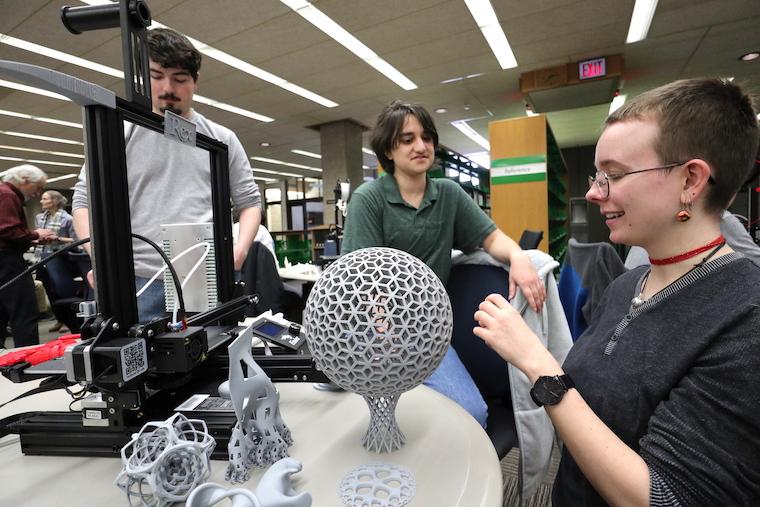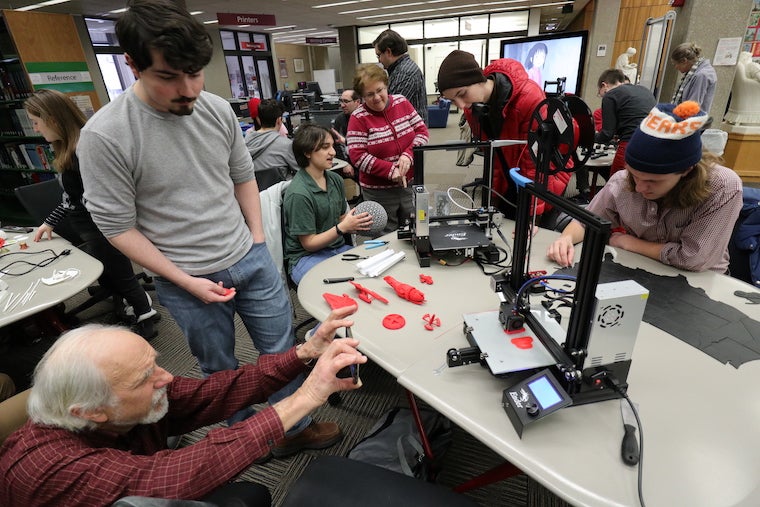3D-Printing 101: If You Need It, Make It
February 21, 2019
Jane Hobson ’22

3D-Printing 101 students present their work to Oberlin community members.
Photo credit: John Seyfried
This winter term, Abe Reshad, associate director of language technology and academic support and Chris Mohler, computer system administrator, led 3D-Printing 101, an on-campus immersive exploration of this process.
During the first week of 3D-Printing 101, students were each assigned their own 3D-printer, which they were also able to keep after winter term. As a class, the students worked to assemble their printers, update the software, and fine-tune the system settings. Afterward, each student brought their printer back to their residence hall to begin individual projects.
Students began individual projects by printing fan guards and wire supports to improve the safety and technology of the printers. Sophomore Ian Moo, who took part in the winter term, explains, “One of the core elements of this class was using our 3D-printers to make parts to upgrade our printers: we needed parts, so we made them. You can apply that philosophy to a lot of things. If you need a part, you can make it. If something doesn’t work, make it work.”
After upgrading their printers, students were given open assignments that allowed them to get more creative. Most of them started out by downloading and printing free open-source hardware designs from databases like Thingiverse. Reshad and Mohler also taught students how to develop computer-aided design (CAD) using a 3D-graphics application, which allowed students to make their own original print designs.
At the end of the month, the project wrapped up with an open exposition in the Terrell Main Library, where students were given a platform to display their work to each other as well as to members of the Oberlin community.

Photo by John Seyfried
For many students, the project hasn’t really ended; they plan to continue learning about 3D-printing, designing new things, and contributing to the maker space on campus. For instance, Moo hopes to come up with creative uses for their printer.
“I’ve already started using my 3D-printer in other projects,” Moo says. “I was fixing up an old typewriter, and it needed some parts to be fully functional, so I designed and 3D-printed them and had the machine working by the end of the night. I’m also thinking I might learn more advanced 3D-modeling and sell my designs. I found out through this class that there’s a very lucrative market for printable 3D-models, and it would be an exciting hobby to get into.”
Another participant, first-year neuroscience major Lilia Welsh, also hopes to start a small business selling her 3D-creations. She says, “I’d like to eventually sell things to my friends here and back home. If it goes well, I’ll probably advertise to some other students here. I’ve already gotten a couple requests. I’m pretty confident people will have an interest in it.”
This is the first year that Oberlin has offered a 3D-printing course during winter term, marking a new opportunity for Obies to get involved in innovative high-tech projects.
Moo remarks, “I’d say this is exactly the type of problem-solving technological learning we need in schools. Programs like this teach some niche skills, sure, but they also teach a really cool philosophy about problems and how to approach them.”
You may also like…
Making a Difference with Business
Omukoko Okoth ’25 chose Oberlin College for its values and opportunities, and in order to take advantage of all that Oberlin has to offer, he decided to participate in the business integrative concentration.
Oberlin Musicians Collaborate at California’s Hidden Valley Institute
Winter Term projects culminate in performances involving TIMARA, dance, chamber music, and jazz.
Health for All
Annie Griffith turned to Montana to serve in a fellow Obie’s reproductive health clinic.


